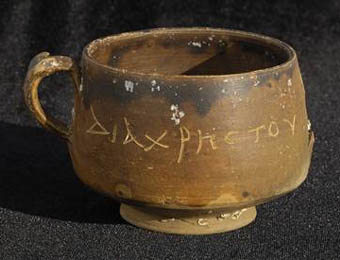The Jesus Bowl
The Biblical book of Acts recounts the tale of a group of Jews who tried to get in on the Christian scene by invoking the name of Jesus in their exorcisms. Confronted with a mad man, possessed according to ancient belief by a god - and by Christian belief by a devil - they chanted, "In the name of Jesus whom Paul preaches". The result was one of the few bits of humour in the Bible: shouting, "Paul I know and Jesus I know, but who are you?" the mad man leaped on them, beat them up and drove them from the house.
Jews had a reputation in the ancient world as exorcists. A typical exorcism involved burning foul-smelling herbs and other noxious substances - presumably on the basis that the devil prefers perfume and would be repelled by bad smells, chanting passages from the Hebrew Scriptures and invoking the names of supposedly powerful angels. The few which have come down to us are such jaw-breaking combinations of consonants that they were clearly invented to sound impressive.
Whether you regard the insane as psychologically disturbed or as actually devil possessed, it is clear that unpleasant odours and harsh-sounding names are not going to effect a cure, so it is hardly surprising that the practitioners of exorcisms should have eagerly seized upon something more effective - and as Paul appeared to achieve good results with the name "Jesus", it is entirely true-to-life that his rivals should have experimented with the same name.
Still, despite being true-to-life, the story could be regarded as nothing more than Christian propaganda were it not for a recent discovery by Frank Goddio, the underwater archaeologist who has been in the news several times in past years for his discoveries at Alexandria. He claims - almost certainly correctly - to have discovered remains of the famous Pharos of Alexandria and also of Cleopatra's palace, the place where the naked teenager tumbled out of a carpet and into the heart of Julius Caesar.

|
| The bowl found by Frank Goddio on which is inscribed the name 'Christ'. |
His most recent underwater discovery is of a bowl or cup (for it has a handle) on which someone has scratched the words "dia christou o goistais", which translates as "through Christ the magician". The style of the object places it somewhere between late 2nd century BC and the first century AD.
As with so much else in archaeology, the discovery probably raises more questions than it answers. "Christos" is simply the Greek for "anointed one" and is the usual translation for the Hebrew word "Meshiach" or "Messiah". It could, however, refer to anyone who was anointed in some way - a priest or a prince or even an initiate into a mystery religion. It is not certain, therefore, that the bowl is referring to Jesus Christ; it could be one of the many false messiahs who afflicted Judaism around the time of Jesus or even just someone who wished to sound impressive and so referred back to his initiation ceremony.
Similarly the word "goistais", for although it means "magician", Bert Smith, professor of Classical Archaeology and Art at Oxford University, postulates that there may have been a religious society called "Ogoistais", while others point to a possible link wit the god "Osogo" or "Ogoa" referred to by Strabo.
The most likely explanation, however, comes from Egyptologist David Fabre, who points to two early Egyptian statuettes which apparently depict a soothsayer practising his craft and holding a cup or bowl very similar in appearance to the one Goddio has found. He suggests that the soothsayer would have filled the cup with water and then added a few drops of oil, then interpreted the patterns formed by the oil in order to foretell the future or give advice.
Despite all these questions, however, the possibility remains that this bowl is evidence for some ancient exorcist or soothsayer trying to cash in on the popularity of Jesus Christ by using His name in his incantations. Given that Alexandria had a very large Jewish population, it is also possible that the exorcist in question was a Jew. The fact that the bowl was discarded unbroken may indicate that the Alexandrian exorcist was as unsuccessful in hijacking the name of Christ as his Ephesian contemporaries.
© Kendall K. Down 2009





